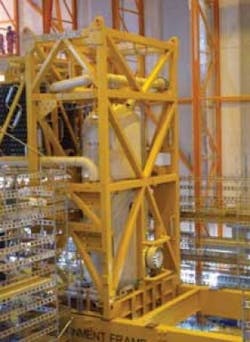Subsea compression tests could determine long-term future of Ormen Lange field
Nick Terdre
Contributing Editor
Subsea gas compression is an emerging technology that could facilitate longer step-out developments. It would allow operators to extend the limits set by reservoir pressure on how far a wellstream can travel – possibly dramatically, once the technology is perfected.
In the Norwegian Sea, subsea compression is under consideration for a future phase of Norske Shell’s Ormen Lange project. The field came onstream in 2007 via subsea facilities: these deliver produced gas directly to a terminal at Nyhamna on Norway’s west coast through dual 120-km (74.6-mi) pipelines, starting in a water depth of 850 m (2,789 ft) at the field center. However, towards 2017 the wellstream will probably need boosting if the field’s recoverable potential is to be fully realized.
In 2007 the Ormen Lange licensees, including DONG Energy, ExxonMobil, Petoro and Statoil, committed to a NOK2.5 billion ($430 million) pilot project to design, build, and test a subsea compression system. Contracts were let to Aker Solutions, then operating as Aker Kvaerner Subsea, for delivery of the complete subsea compression station, and Vetco Gray, now GE, for the power supply. Aker Solutions selected Nuovo Pignone, now also part of GE, for delivery of the compressor, while Vetco subcontracted ABB to provide support for the transformer development and Nexans for the power/control cable.
(Above) The Ormen Lange subsea compression pilot system recently underwent dry testing in a clean hall at Aker Solution’s Egersund yard in Norway. (Right) The separator stands 7 m (23 ft) high and has an ID of 3 m (9.8 ft). It can handle slugs of up to 10 cu m.
But before a decision on using subsea compression can be taken, the technology must prove advantageous compared with alternative methods. The base case for Ormen Lange compression, as laid out in the Plan for Development and Operation approved by Norway’s government in 2004, calls for a surface system using proven technology. According to Bernt Granås, the Ormen Lange project manager, this is a TLP with a 22-26,000-metric ton (24,251-28,660-ton) topsides run by a crew of 20-40.
The subsea compression equipment envisaged for Ormen Lange is itself of a daunting size. It comprises a four-train station, weighing around 8,000 mt (8,818 t), according to Håkon Skofteland, Aker Solutions’ project manager. Each train will have a 12.5 MW power supply need, and the whole system will require 58 MW. It has to boost the pressure of the wellstream flow from 80 to 140 bar (1,160 to 2,030 psi), while handling throughput of 60 MMcm/d in a water depth of 900 m (2,953 ft). The availability target is 97.6%. And reliability and robustness will be critical, given the difficulty of intervention in a seabed system far from land.
The single-train pilot system was assembled last year at Aker Solutions’ Egersund yard in western Norway, where a “clean” hall costing NOK40 million ($7.2 million) was purpose built. The various modules and associated components had already been tested by the vendors prior to delivery. They were then hooked up together and between November and February this year the whole system, as well as combinations of the different parts, were subjected to a battery of dry tests.
Skofteland was satisfied with the results. “We’ve learnt a lot during the system testing and there have been some challenges which we have managed and solved in a good way,” he said. “I’m looking forward to the testing at Nyhamna and to proving this technology.”
Following this program, the pilot system, which weighs 1,100 mt (1,212 t), was due to be dismantled and shipped to Nyhamna. There it will be reassembled in a purpose-built test pit, 14 m (46 ft) deep, which will then be flooded with sea water. From around mid-2011 it will be subjected to six months of performance testing using the unprocessed wellstream arriving from Ormen Lange. A specially designed process module weighing some 900 mt (992 t) will make it possible to simulate the full range of wellstream conditions which the system would likely encounter on the seabed.
Next year, armed with the results of the performance testing, the licensees will determine the final form of endurance testing that will follow. They will also decide whether to commit to subsea compression on Ormen Lange, a decision which, Granås stresses, will be based on an overall assessment of relevant factors, including cost, effectiveness, reliability, and HSE performance. It is difficult to say at this stage whether the subsea or floater solution offers greater additional reserves recovery, he says. No information has been issued on comparative costs.
Pilot system
On reaching the Ormen Lange subsea compression station, the wellstream will first pass through a vertical two-phase separator standing 7 m (23 ft) high and with an internal diameter of 3 m (9.8 ft). This unit, designed by Aker Solutions, divides out the liquids, including condensate slugs, as well as particles such as sand.
The gas then passes through the compressor, which is designed for submerged operation based on a proprietary subsea design solution devised by Aker Solutions. The compressor, a GE Blu C model, and the high-speed motor, a Converteam MGV model, operate in a vertical position. The compressor unit has undergone drastic design modifications to make it suitable for subsea service. Its shaft rotates at 12,000 rpm in a gas-filled, hermetically-sealed and pressurized enclosure; magnetic bearings are used to eliminate the need for lubrication. Use of a high-speed motor also renders gears and couplings unnecessary. The motor and compressor are integrated in the same housing, avoiding the need for seals and also making for relative compactness – the whole compressor module weighs 140 mt (154 t) and is around 12 m (39.3 ft) high.
In parallel the liquids, consisting mainly of condensate and water, pass through a 400 kW booster pump – a single-phase version of Aker Solutions’ proprietary LiquidBooster design – capable of handling 17,400 b/d of condensate. The gas and liquids are then reunited for their journey to shore.
Both the compressor and the liquids booster pump are connected to variable-speed drive modules through which their respective motor speeds are controlled. There is also an anti-surge cooler module with a design duty of around 9 MW to cool the gas in the event of compressor anti-surge operation.
Control of the system is exercised through an all-electric system, again developed by Aker Solutions. Battery back-up for the control system is supplied in the form of two UPS – uninterruptible power supply – modules, providing complete redundancy.
Aside from enabling longer step-outs, subsea compression also offers better rates of recovery than surface systems, as compression is more efficient the closer it is located to the wellhead. Development costs notwithstanding, the technology has lower associated capex and opex than surface alternatives; involves less risk to offshore personnel; brings a reduced environmental footprint, and lower power consumption. Adding this technology to the offshore toolbox could significantly expand production capabilities at sea.
Åsgard debut
The first subsea compression system is due to come into operation in 2014 on Statoil’s Åsgard project, also in the Norwegian Sea. The operator and its partners Eni, ExxonMobil, Petoro, and Total took this pioneering decision last October following a lengthy qualification program. The application does not involve a particularly long stepout – the system will be installed downstream of the Midgard field, which delivers gas and condensate to the Åsgard B floating platform 40 km (24.8 mi) to the west. Including the Mikkel field, production from which is routed to Åsgard B via Midgard, subsea compression could bring additional recovery estimated at 28 bcm of gas and 14 MMbbl of condensate.
Subsea compression was compared with two topside alternatives based on well-proven technology: either locating the compression facilities on the Åsgard B platform or on a new platform on Midgard. Both have drawbacks. For the Åsgard B option, the potential for additional recovery is greatly reduced due to the diminished efficiency of compression at the destination. But a dedicated platform on Midgard would be significantly more costly than subsea facilities, although in terms of the additional recovery it is not far behind the subsea solution, according to Torstein Vinterstø, facilities project manager for Åsgard Subsea Compression.
Aker Solutions was awarded a NOK3.4-billion ($610-million) EPC contract last December to design and construct the subsea system. In January MAN Diesel & Turbo was contracted to deliver four 10 MW compressor units to Aker Solutions in 2012. These will be built to the company’s proprietary Hofim design, with integrated motors and magnetic bearings, and hermetically sealed.
Two of the compressor units will be installed on the seabed at any time, according to Vinterstø. They will be incorporated in two separate trains operating in parallel, though when production starts to tail off, they could be put to work in series to maximize hydrocarbon extraction.
The subsea compression station, which will be installed in 250 m (820 ft) water depth, will measure 70 x 40 x 20 m (229 x 131 x 66 ft) and weigh around 3,500 mt (3,858 t). Production from the two fields will be routed through a manifold to the station, which will have the capacity to compress 21 MMcm/d of gas, boosting the pressure of the flow in the different lines by roughly three times.
The wellstream, both in part and in whole, will also be able to bypass the compression station, allowing flexibility in its operation. Power will be provided from the Åsgard A production ship 40 km distant. It will be stepped up from 24 kV over the ship’s swivel to 36 kV for transmission on the seabed, then down again to 6.6kV for consumption in the compression station.
While details of the Åsgard and Ormen Lange applications vary, the basic challenges faced by the two projects are the same. In 2009 the two sets of licensees agreed that there would be mutual benefits in sharing information and seeking to capture development synergies between the two projects, and a memorandum of understanding to this effect was signed last year.
Looking to the future
Through its legacy companies, Aker Solutions can trace its involvement in the development of subsea compression technology back to the beginning. The idea was first proposed in 1985 by Kjell Olav Stinessen, who then worked for Kvaerner and is now Aker Solution’s first chief engineer for subsea compression. A notable milestone in the development was the Kvaerner Booster Station, presented to the market in 1993, but which proved to be way ahead of its time.
While not forgetting the roots of the technology, Aker Solutions is now looking forward to the next stages beyond Åsgard and Ormen Lange. One line of development is to expand the envelope of application to encompass longer stepouts, deeper installations, higher duties and harsher environments.
But there are also many smaller fields which could benefit from the technology, Stinessen says. These will require simpler, more compact and lower-duty systems. Aker Solutions has developed the concept for a 6MW wet gas compression train weighing only 150 metric tons (165 tons), and incorporating a compact compressor module, a compact active cooler and a frequency step-up unit, all using patented technology.
Offshore Articles Archives
View Oil and Gas Articles on PennEnergy.com


